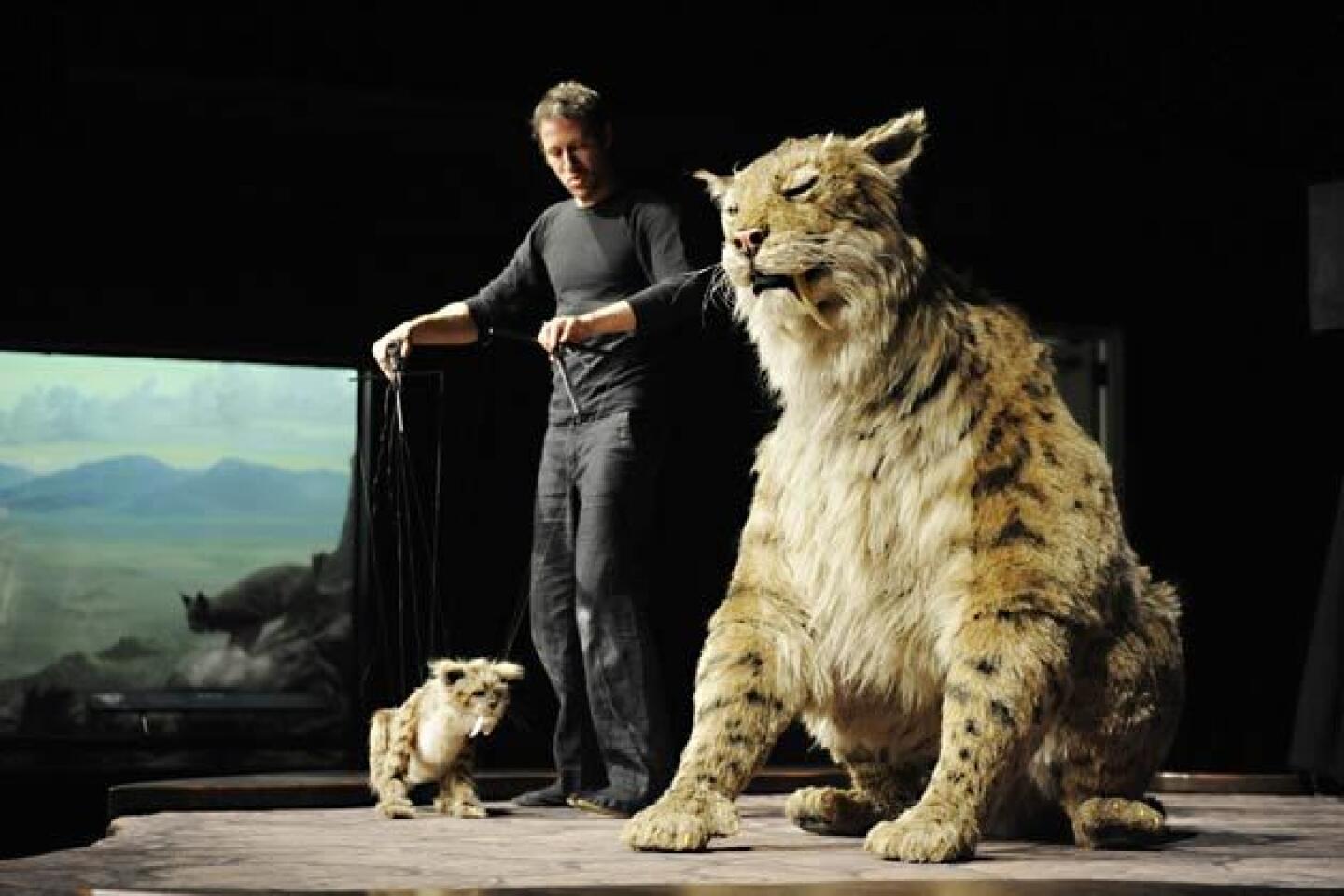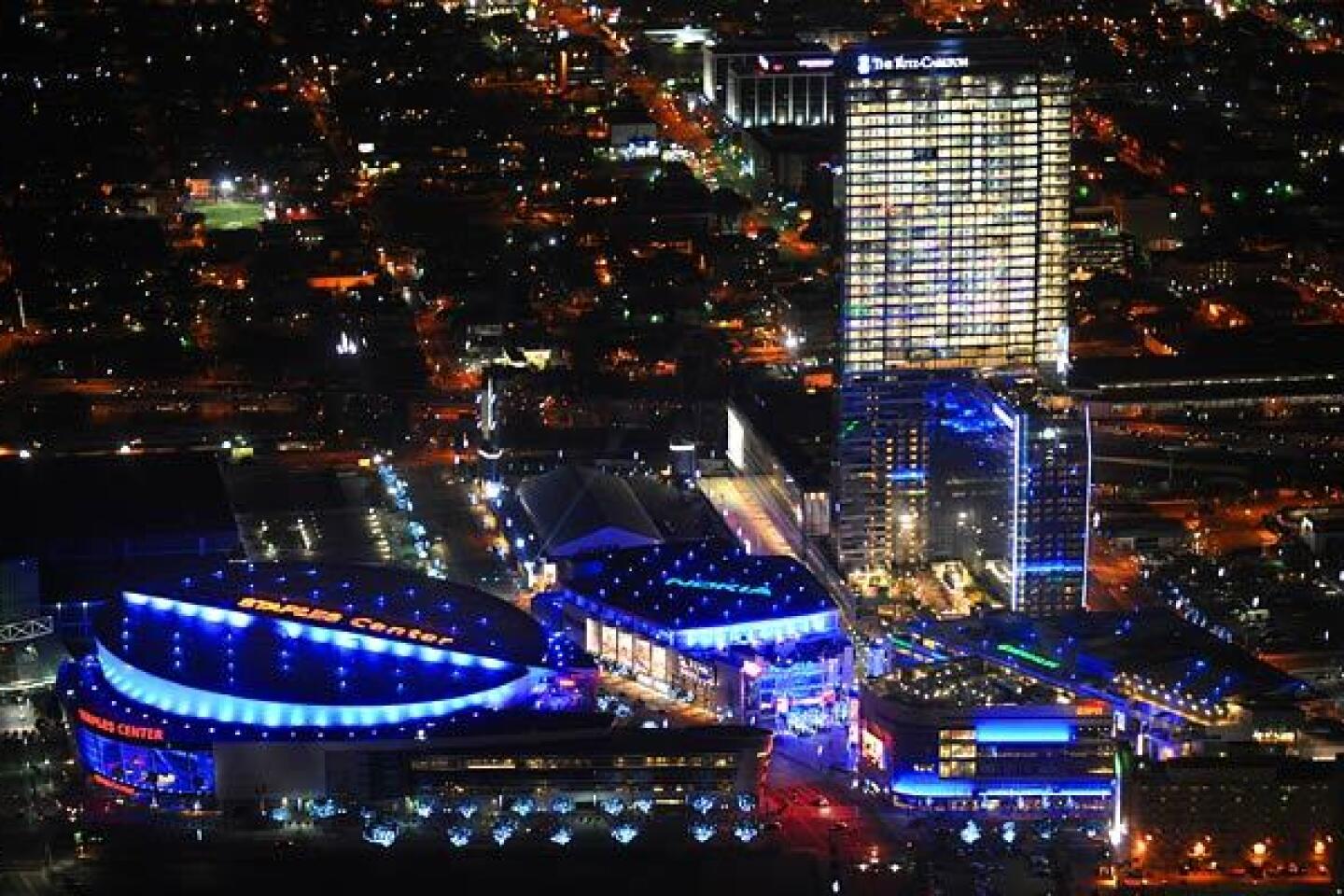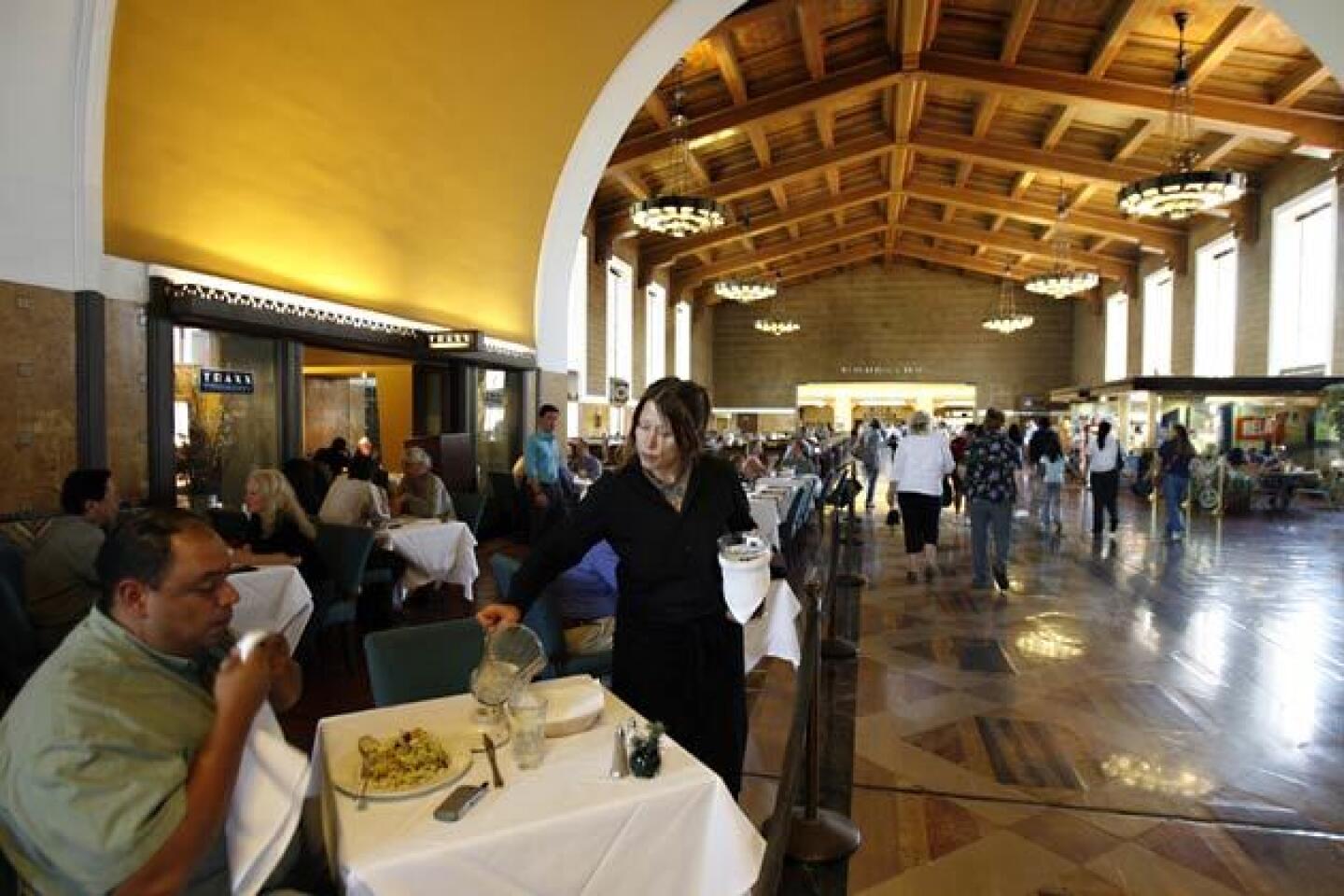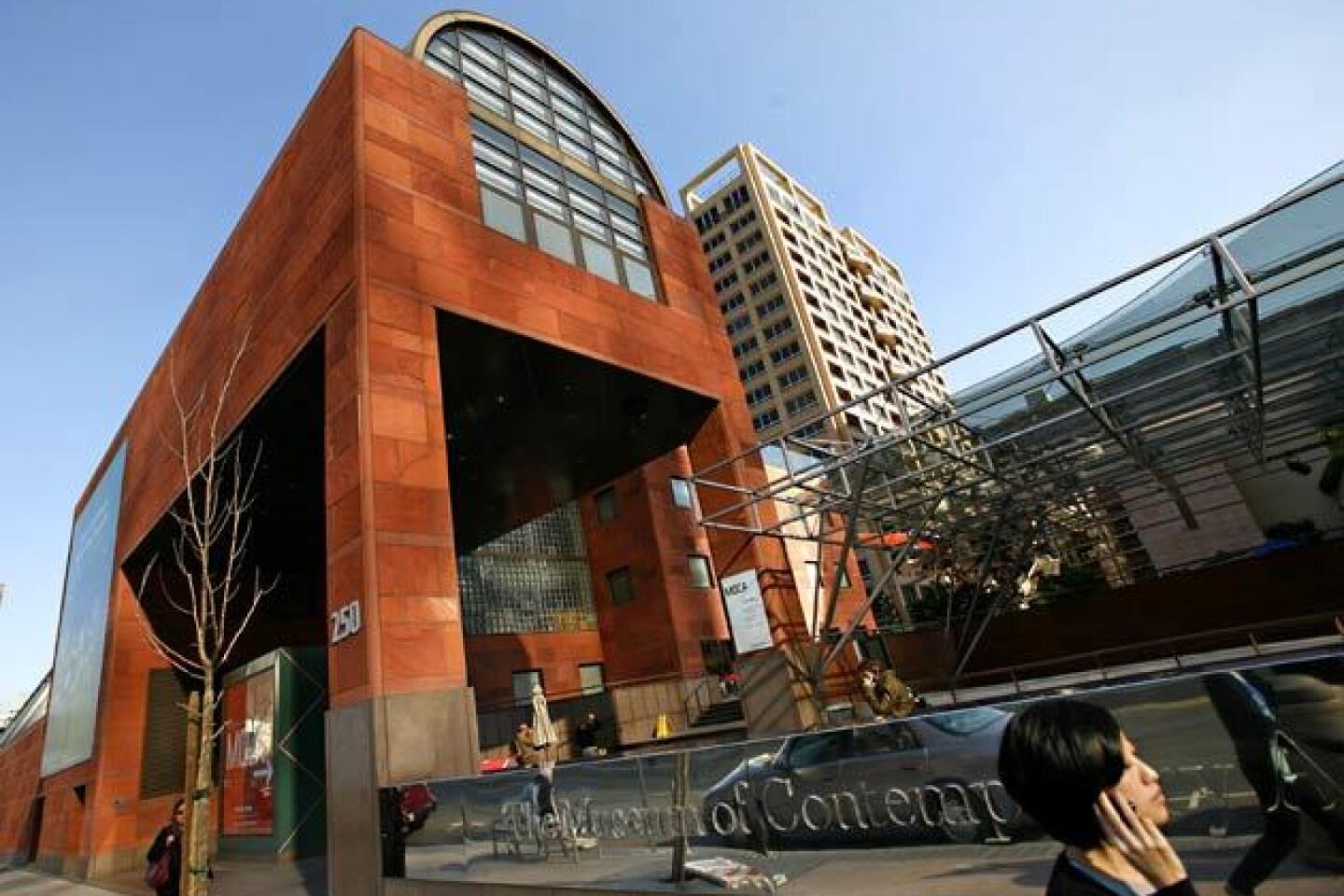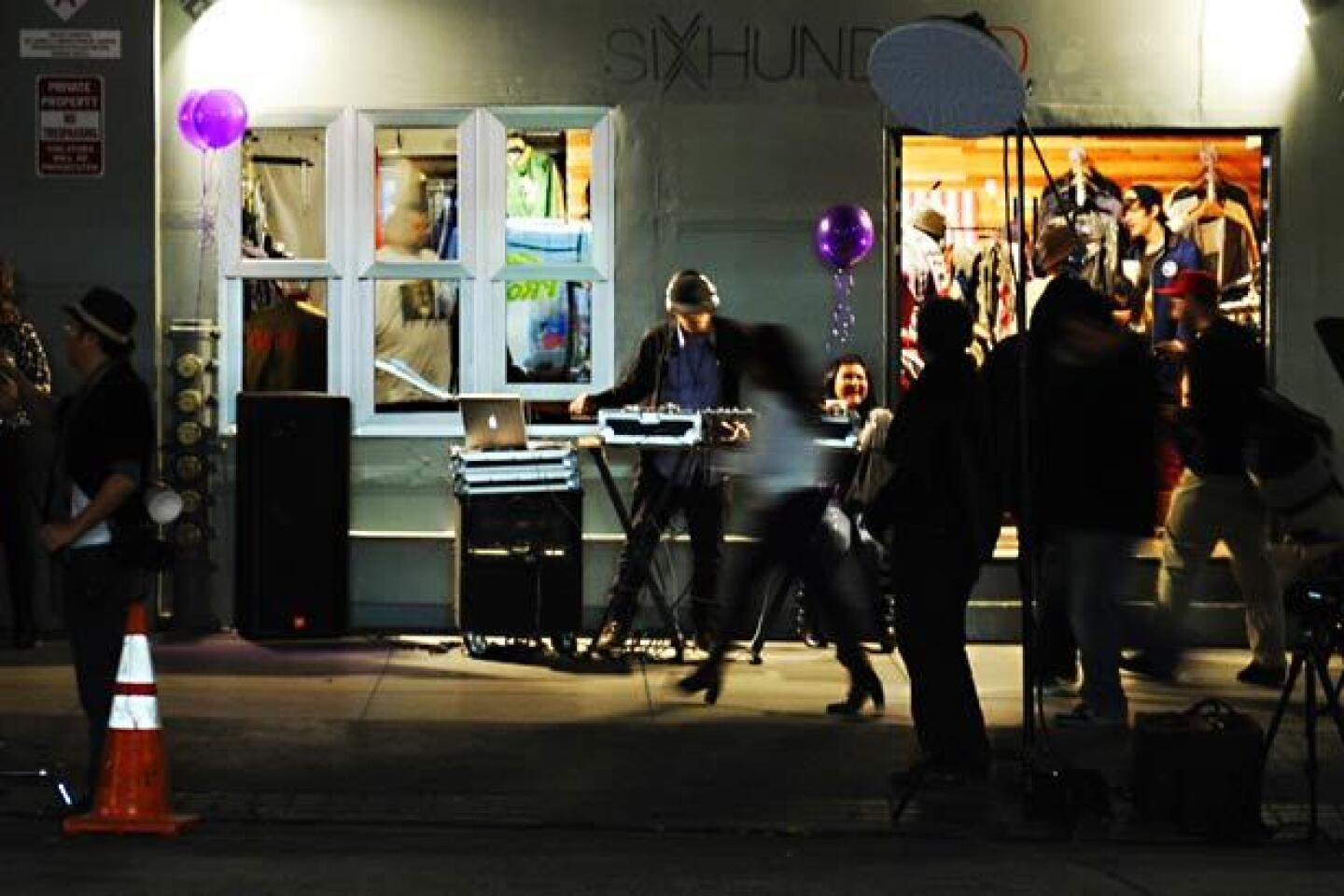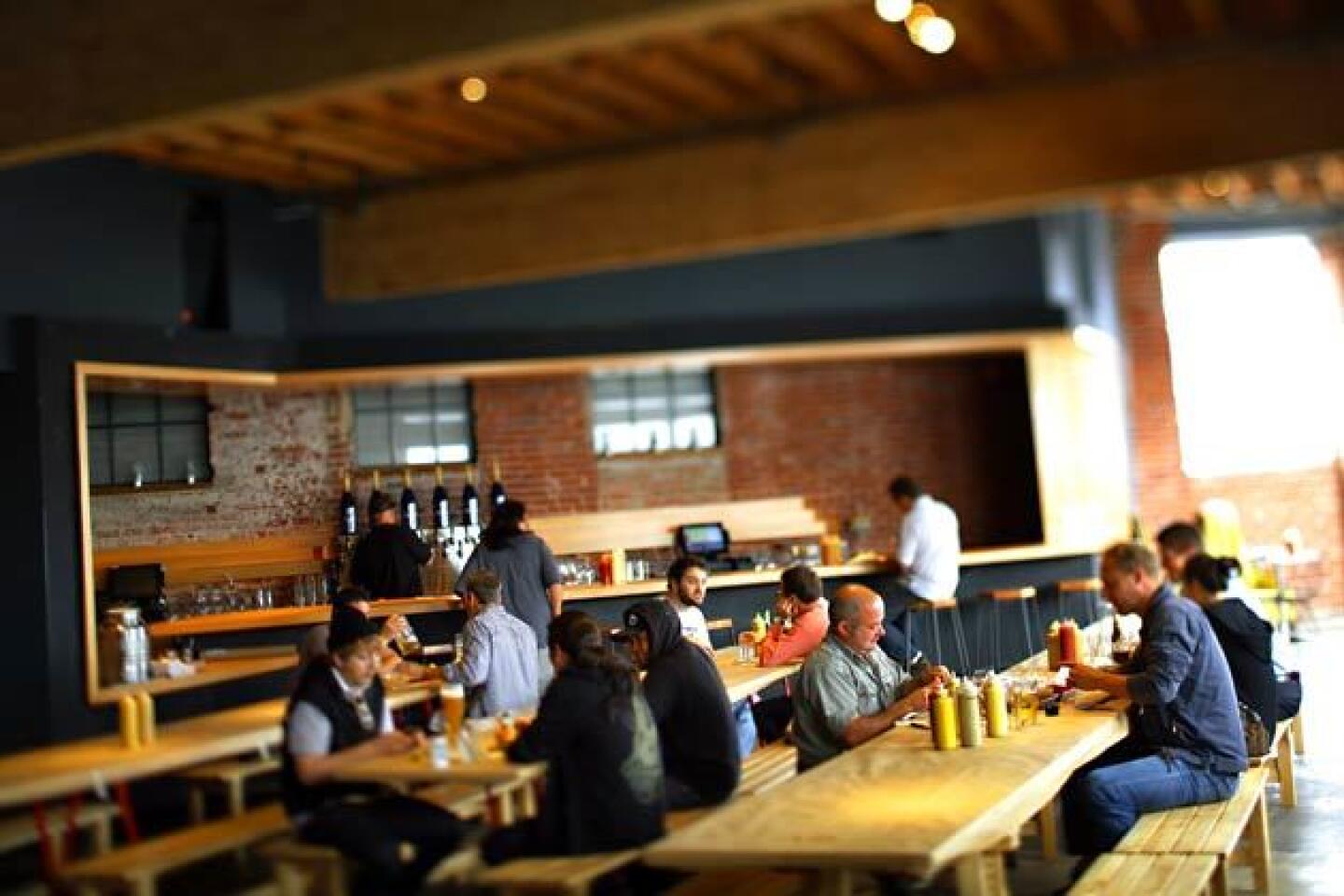Southern California Close-Ups: Downtown Los Angeles
First published on Jan. 30, 2011. Revised and expanded in early 2012.
The tourists think big. Arriving in Southern California, they expect to conquer Disneyland and Hollywood, perhaps on the same day, in between the surfing and snowboarding. Then they get stuck in traffic. Then come the recriminations, the tears, the vows to visit an island next time.
The locals think small. Tracing tight little loops between home and work, they dodge freeways and alien neighborhoods. There are Los Feliz people who haven’t set foot in Venice since the latter Bush administration (until this project, I was one), and there are Santa Monica people who have never stood at Griffith Observatory, watching the glittering grid of the city spread before them at dusk. (It’s free, people.) Downtown sits in the middle of all of this, but to thousands of Angelenos, it’s more remote than Manhattan, never mind Manhattan Beach.
What we have here, whether you’re a tourist or a local, is a failure to fully appreciate the wonders and weirdness of Southern California. So I offer these 12 chapters of close-ups, beginning with downtown Los Angeles.
They cover kid stuff, adult stuff, food, lodging, roller derby, historic architecture and what to sniff when you’re in the Central Library. They may be a tad more opinionated and intimate than your average guidebook, because I think you want to make human connections, not just check off a bucket list.
These micro-itineraries bring together two or three neighboring destinations to make a single adventure. Others stand alone, like those odd, irresistible Joshua Trees out in the desert. Try a few, and maybe you’ll see L.A. anew.
1. Where T-rex roars
You can spend hours meandering Exposition Park near USC -- the California Science Center, the California African American Museum, the Rose Garden. But not today. Today, you and your child are heading straight to the Natural History Museum of Los Angeles County (900 Exposition Blvd., www.nhm.org), and you’ll start by browsing the long hallways filled with old-school dioramas, an Age of Mammals exhibit that opened in 2010, and a Dinosaur Hall that opened in 2011. Then you head upstairs to the second-floor North American Mammal area, where, since 2008, museum performance artists have been staging Dinosaur Encounters and Ice Age Encounters several days a week. It’s only a 15- or 20-minute show, but the star is a living, breathing, life-sized animal puppet -- a 15-foot baby Tyrannosaurus rex. “Who thinks he eats peanut butter and jelly sandwiches?” asks Carissa Barnett, as the dinosaur (inhabited by another performer) snarls and snaps. Half-smitten and half-scared, the children hang on Barnett’s every word about the food chain and extinction. Shows are offered two or three times daily (check www.nhm.org for days and times), and the museum’s Ice Age Encounters (with a sabre-toothed cat mother and child) are comparable.
2. Quiet and cool smells, then din and dining
Shhh. You’re going to the library. The big one on 5th Street (630 W. 5th St., www.lapl.org/central), with the strange pyramid on top that deserves a role in the next overwrought Nicolas Cage conspiracy movie. Don’t be put off by the street people at the entrance or the low ceilings on the ground floor. Climb one level and behold the soaring rotunda, full of spectacular murals painted in 1933 -- conquistadors, friars, Native Americans and European settlers, not to mention the globe chandelier that throws light on them. Then step into the Children’s Literature room next door, where (above the low-hanging fluorescent lights) you’ll find another set of California historic scenes. Now follow the advice of Monica May, chef at the Nickel Diner and a downtown veteran, who brings visiting friends here and orders them to sniff the books. Why? “You’re smelling your childhood,” she says. After those acres of quiet, expect a blow to the head when you step through the glass doors of Bottega Louie Restaurant & Gourmet Market (700 S. Grand Ave., www.bottegalouie.com). That’s how it feels the first time you confront the restaurant’s signature din, the roar of a few hundred diners and a revved-up sound system, all bouncing off marble floors and empty whitewashed walls, echoing under 40-foot-high ceilings. But give it a minute, and notice the gleaming green éclairs, the gluten-free macarons, the legions of chefs in the wide-open kitchen. Since opening in 2009, this eatery has won a reputation for genial service, good Italian food and reasonable prices. It’s so noisy that no one will notice a garrulous child. And if you don’t want a meal, there’s always the bar in front or the desserts in the bakery. No reservations are accepted, so arrive early or expect to wait.
3. The Tarzan factor
You’re all about sports, and you’ve scored tickets to see the Clippers or Kings or Lakers at Staples Center (1111 S. Figueroa St., www.staplescenter.com), next to the L.A. Live entertainment complex and Los Angeles Convention Center (1201 S. Figueroa St., www.lacclink.com) near the southern end of downtown. Congratulations, especially if those are Laker seats. Now, there are more than a dozen restaurants and bars in L.A. Live (800 W. Olympic Blvd., www.lalive.com), not to mention the Grammy Museum, a JW Marriott Hotel and a Ritz-Carlton, both of which opened in 2010. But that’s not where you’re eating or sleeping tonight. You’ve made pregame reservations at Rivera Restaurant (1050 S. Flower St., www.riverarestaurant.com), where chef John Sedlar will confront you with some of the most boldly modern and fussily presented Modern Latin cuisine you’ve ever encountered. Even the floor plan will throw you; tables are arranged into zones representing Europe, North America and South America. And after the game? Maybe a nightcap in L.A. Live. But if it’s Friday or Saturday, think about the Veranda Bar at the Moroccan-flavored Figueroa Hotel (939 S. Figueroa St., www.figueroahotel.com), which stays open past 1 a.m. on weekends but closes earlier other nights. Then, when it’s time to go home, you retire to the Los Angeles Athletic Club (431 W. 7th St., www.laac.com), which has 72 hotel rooms that many people have never heard about. From the outside, the LAAC is a humdrum hulk among the gem merchants that make up downtown’s Jewelry District, but inside, it’s a piece of sweat-soaked L.A. history, with two restaurants and bars, pools, weights, squash courts, basketball courts and walls crowded with fascinating old artwork and photos. Book a room, and you get the same access as the club’s members. (Yes, male and female, adults and children.) The hotel rooms, upgraded from 2007-2009, are dark, woodsy and clubby. For less than the cost of a room at the Marriott or Ritz, you can walk and run in the footsteps of Esther Williams, Johnny Weissmuller and dozens of less-celebrated Olympic medalists. (Charlie Chaplin spent a lot of time here too.) Alas, the indoor pool’s high dive is no more, but you can still peek through the underwater window that diving coaches used to watch their proteges splash down.
4. Astroturf, movie memories and vistas
Atop the Standard Hotel (550 S. Flower St., www.standardhotels.com/los-angeles), you’ll find a pool (guests only), fireplace, synthetic turf deck, goofy topiary and a trendy open-air bar with skyscraper views on all sides. Scan the horizon, quaff a beer or cocktail, then descend and head two blocks east to the Millennium Biltmore Hotel (506 S. Grand Ave., www.millenniumhotels.com/millenniumlosangeles). Stroll down the broad corridors of this grand old pile (where many early Oscar ceremonies were staged, beginning in the ‘30s), and imagine the whole place upside-down and wet. Yes, parts of “The Poseidon Adventure” (the 1972 version) were shot in this lobby. Down the hall you’ll find the hotel’s stately Gallery Bar, where most nights, veteran bartender Greg Guzelian will be pleased to assess your demeanor and pour you, as seems appropriate, a French Kiss or a Black Dahlia. These pricey drinks are his own creations. If ‘70s nostalgia takes hold, somebody may suggest an elevator ride to the revolving Bona Vista cocktail lounge on the 34th floor of the tired but striking Westin Bonaventure Hotel (404 S. Figueroa Ave., www.thebonaventure.com), built in 1976 at 4th and Figueroa. Choose the future instead: a dinner splurge at WP24 on the 24th floor of the Ritz-Carlton (900 W. Olympic Blvd., www.wolfgangpuck.com/restaurants/fine-dining/57129).
5. Street food and “Blade Runner”
“Are you Jose?” somebody asks the Asian man behind the counter of Jose’s Ice Cream Shop in Grand Central Market at 317 S. Broadway (www.grandcentralsquare.com). “Yes,” he says, handing over a scoop of pistachio. This market is all about mixing it up. Carpeted with sawdust and illuminated by a jumble of neon signs, the open-air market dates to 1917. It offers produce, meats and street food of many countries (especially Mexico). Head to Tacos Tumbras a Tomas (Stall A5, on the left, halfway back) and order a taco or burrito. Massive servings, tasty too. Then wander to the market’s rear entrance on Hill, where you can check out the twin orange cars of the Angels Flight Railway (351 S. Hill St., www.angelsflight.com), a rebuilt funicular that, for a quarter (though a bump to 50 cents has been threatened) will take you 298 feet up Bunker Hill to the splashing fountains and gleaming skyscrapers of the California Plaza Watercourt. (The railway opened in 1901, about a block from its current location, and was later closed, rehabbed, closed and rehabbed again, reopening in 2010.) Now, head back to the market’s front entrance, cross Broadway and step into the Bradbury Building (304 S. Broadway), a five-story, glazed-brick-and-cast-iron marvel that went up in 1893. Architect George Wyman was inspired by an imaginary building in a science-fiction story. Then, decades later, director Ridley Scott seized on the Bradbury as a set for his 1982 film “Blade Runner.” It’s free to stroll the ground level of the Bradbury, whose tenants include the LAPD Internal Affairs unit and Ross Cutlery, where you can use the old-fashioned scale for a dime.
6. Noodles in Chinatown
L.A.’s Chinatown can’t match San Francisco’s or New York’s for pedestrian friendliness or retail and restaurant variety. But this Chinatown has its own story. The original neighborhood was leveled to make way for Union Station in the 1930s, so the community rebuilt itself a few blocks to the northwest. You can get ginseng by the barrel or dried shiitake mushrooms by the pound or inspect a vast selection of teas and traditional cures at Wing Hop Fung in Far East Plaza (727 N. Broadway, No. 102, www.winghopfung.com). Then, for a modern spin, head up to Realm (425 Gin Ling Way, www.realmhome.com), a retail haven of stylish home items. Under the lanterns in the courtyard outside, you can find colorful toys and tourist gimcracks along with a few fledgling art galleries, quality variable. Among restaurants here, Yang Chow (819 N. Broadway, www.yangchow.com) has the greatest wall of fame and a pleasant atmosphere, and Phoenix Bakery (969 N. Broadway, www.phoenixbakeryinc.com) has tempting sweets. But you’re going to double back to Far East Plaza for a cheap, healthful lunch and a reminder that Chinatown isn’t just Chinese anymore. Hoan Kiem, the square little Vietnamese restaurant space at 727 N. Broadway, No. 130 (no website), offers just a handful of dishes, including pho (chicken noodle soup), rice crepes and rice with chicken. “We want quality, not quantity,” says hostess and co-owner Lien Ha. “That’s the mentality in our family.”
7. Union Station and Olvera Street
Angelenos sometimes avoid Olvera Street (845 N. Alameda St., www.elpueblo.lacity.org), maybe because its genuinely historic buildings are crowded by vendors and carts peddling cheap trinkets, maybe because parking can cost a small fortune, maybe because the neighboring buildings seem to have been under renovation longer than most of Los Angeles has been standing. But this is where settlers from Mexico founded Los Angeles in the late 18th century, and it’s where the 1818 Avila Adobe, the oldest home in Los Angeles, still stands. And it’s an excuse to see Union Station. To visit, leave your car behind and take a Metro train to Union Station (800 N. Alameda St.), and linger. This 1939 building is the last grand train station built in the U.S., and its entwined Art Deco and Spanish Colonial styles suggest the mansion Hernando Cortes might have built had he married a flapper. Traxx (www.traxxrestaurant.com), an upscale bar-restaurant, is tucked just inside the main entrance. Now, head across Alameda Street and walk the crowded alley that is Olvera Street. Unless you need a plastic guitar or wrestler’s mask, stroll briskly past the stalls on your way to browse the more varied goods at Olverita’s Village (No. 24, www.olveritas.com). Then take a patio seat at La Golondrina (No. 17), one of several restaurants on the alley. It’s not awesome food, but it’s hearty. And if it’s Friday night, you’ll probably have a five- or six-man mariachi playing for free. If it’s not a Friday, think twice before you hire those strolling singer-guitarists. They’ve been known to ask as much as $4 per guy per song.
8. Disney Hall, inside, outside, across the street
Don’t you want to lay hands on Disney Hall? Frank Gehry’s rippling metallic beauty at 111 S. Grand Ave. is nearly irresistible, and the Los Angeles Philharmonic (www.laphil.com) keeps it busy. Acclaimed young conductor Gustavo Dudamel leads about 40 performances each season, and the hall books jazz and world music too. But tickets are dear, so you might just take a free building tour, which doesn’t cover the auditorium but does let you creep up and around the exterior. Most days, they hand out headphones between 10 a.m. and 2 p.m., and sometimes there are live guides. (Check www.musiccenter.org/visit/toursched.html) Now, notice the Colburn School (200 S. Grand Ave., www.colburnschool.edu), the music and performing arts conservatory just across Grand Avenue. It plays Juilliard to Disney’s Carnegie Hall. And on Friday and Saturday nights, there are often concerts by students, faculty and visiting artists in the Colburn’s 415-seat Zipper Hall, at notably sub-Disney prices. The Colburn Cafe, a breakfast and lunch stop, is often used by music students and their families. From there it’s also an easy walk to the Music Center (135 N. Grand Ave., www.musiccenter.org), the Museum of Contemporary Art (250 S. Grand Ave., www.moca.org), the Cathedral of Our Lady of the Angels (555 W. Temple St., www.olacathedral.org) and the outdoor fountains of California Plaza (300-350 S. Grand Ave.), which stages summer concert series (www.grandperformances.org).
9. The walk and the Stay
Downtown’s boosters dream of a 24-hour district teeming with loft dwellers who nightly browse restaurants, bars, galleries and one-of-a-kind shops. We’re not all the way there yet, but if you show up on Spring or Main streets, between 2nd and 9th streets, on the second Thursday evening of any month, you’ll see something like that vision. That’s the night of the Downtown Art Walk, a loosely organized ritual, born in 2004, in which galleries and shops such as the Hive (729 S. Spring St., www.hivegallery.com) stay open late, DJs pop up everywhere, dozens of food trucks roll down Spring and Main streets like Conestoga wagons seizing prime prairie real estate, and hundreds of young artsy urbanites -- some of them loft dwellers, many of them adventurers from elsewhere -- roam the streets under the gaze of police and private security guards. There is a lot of amateurish art. Some people drink too much, and some say the food trucks undercut the area’s restaurants. But there’s a big buzz, and it’s mostly fun. Near the center of the action, you’ll find Stay on Main (636 S. Main St., www.stayonmain.com), a budget lodging with bunk beds and private rooms, and the Smell (247 S. Main St., www.thesmell.org), an all-ages music venue. You’ll also find the Nickel Diner (524 S. Main St., www.nickeldiner.com), serving American comfort food (including maple bacon donuts) near the gritty corner of Main and 5th.
10. The writing on the wall
You can hate most graffiti and still admire the colors, textures and sheer creative energy on the walls of downtown’s Arts District. The “Mona Lisa” on the shed at Rose Street and Traction Avenue, for instance, and the long wall of crazy critters along Garey Street between 2nd and 3rd streets. Of course street art is subject to change, but much of this work was done at the invitation of property owners in this Bohemian, post-industrial ‘hood. You find many artists’ lofts, a few galleries and eateries and the skinniest college ever (the Southern California Institute of Architecture, which occupies a former freight train depot at 3rd Street and Santa Fe Avenue). Hungry? Stop for sushi at R23 (923 E. 2nd St., www.r23.com) or a gourmet hot dog at Wurstkuche (800 E. 3rd St., www.wurstkuche.com).
11. Little Tokyo
Little Tokyo is so close to the civic buildings of downtown that many government workers head out for sushi on their lunch breaks, as do some enterprising jurors. You have something similar in mind. You’re on foot at East 1st and Alameda streets, having just stepped off a Metro train or parked in the nearby public lot. Walk a block west on 1st, keep an eye out for the Koyasan Buddhist Temple (342 E. 1st St., www.koyasanbetsuin.org) and choose now: You can step into the Japanese American National Museum (369 E. 1st St., www.janm.org), which has a history of smart exhibits and a small gift shop. Or you can instead step next door, into the Museum of Contemporary Art’s Geffen Contemporary space (152 N. Central Ave., www.moca.org). Or do both. Along the way, you’re sure to spot a flag and inscribed stonework at the northern terminus of Central Avenue, near East Temple Street. That’s the Go for Broke Monument, which honors the 16,000 Japanese Americans who served overseas for the U.S. in World War II, even as thousands of others suffered in U.S. internment camps (www.goforbroke.org). Heading farther northwest on 1st, you’ll find a medley of Japanese restaurants and retail opportunities, including the Japanese Village Plaza mall (335 E. 2nd St., www.japanesevillageplaza.net), and the Weller Court shopping center (123 Astronaut E.S. Onizuka St.). There’s more in the Little Tokyo Square Shopping Center at 3rd Street and Central Avenue (www.visitlittletokyo.com). But by now you’re ready to eat. To test one of the tastiest and busiest sushi restaurants in town, join the happy masses at Sushi-Gen (422 E. 2nd St., www.sushigenla.com), which serves lunch on weekdays and dinner every day but Sunday. (Don’t let the drab strip-mall exterior fool you.) Alternatively, you could step out of your Asian theme and into a hipster haven: the Lazy Ox Canteen (241 S. San Pedro St., www.lazyoxcanteen.com), which is known for its brilliant burgers. Or split the difference with a green tea doughnut and fancy coffee from Café Dulce (134 Japanese Village Plaza, Building E, www.cafedulce.co). If you still have energy and cultural ambitions, good news -- you’re just a few blocks from the David Henry Hwang Theater (120 N. Judge John Aiso St.), where the East West Players (www.eastwestplayers.org) have been introducing new works and performers since the 1960s.
12. Two words: roller derby
L.A. doesn’t have an NFL team -- yet. Till then, Angelenos have something almost as bruising, a banked-track, all-female roller derby league known as the L.A. Derby Dolls (www.derbydolls.com/LA). Once, sometimes twice a month, about 2,000 people turn out at the rink at 1910 W. Temple St. to watch these tough puppies in unstaged athletic competitions. What happened to all the shtick? Beginning in 2001, the sport’s organizers contend, roller derby abandoned most of its canned-ham stunts in exchange for actual athletic competition in which one woman, known as the jammer, tries to whipsaw-fly-bounce-jounce-cuss her way through the opposing team, gaining a point for every player she passes. It is a decidedly unglamorous but endearing sport that packs the plywood bleachers with folks in search of something different on a Saturday night. The “bouts” are broken into four 15-minute quarters. Before the game, there are craft booths to browse and a live band to enjoy. At halftime, more music, pizza and Tecate beer. This is minimalist sports, a crazy roadhouse atmosphere with mostly 25- to 35-year-olds, but many spectators twice as old. It’s sort of the anti-L.A. scene, the polar opposite of blingy Staples. “There’s not one type of people here,” says fan Joel Mandelkorn, who likes to bring out-of-town guests. “It’s one of those things that, once you know about it, you’re always telling people.” Consider yourself told.
Staff writer Chris Erskine contributed his roller derby expertise to this report.
More to Read
Sign up for The Wild
We’ll help you find the best places to hike, bike and run, as well as the perfect silent spots for meditation and yoga.
You may occasionally receive promotional content from the Los Angeles Times.


